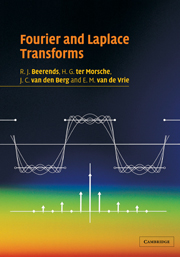Book contents
- Frontmatter
- Contents
- Preface
- Introduction
- Part 1 Applications and foundations
- Part 2 Fourier series
- Part 3 Fourier integrals and distributions
- Part 4 Laplace transforms
- Part 5 Discrete transforms
- 15 Sampling of continuous-time signals
- 16 The discrete Fourier transform
- 17 The Fast Fourier Transform
- 18 The z-transform
- 19 Applications of discrete transforms
- Literature
- Tables of transforms and properties
- Index
15 - Sampling of continuous-time signals
Published online by Cambridge University Press: 05 June 2012
- Frontmatter
- Contents
- Preface
- Introduction
- Part 1 Applications and foundations
- Part 2 Fourier series
- Part 3 Fourier integrals and distributions
- Part 4 Laplace transforms
- Part 5 Discrete transforms
- 15 Sampling of continuous-time signals
- 16 The discrete Fourier transform
- 17 The Fast Fourier Transform
- 18 The z-transform
- 19 Applications of discrete transforms
- Literature
- Tables of transforms and properties
- Index
Summary
INTRODUCTION
In chapter 1 signals were divided into continuous-time and discrete-time signals. Ever since, we have almost exclusively discussed continuous-time signals. This chapter, being the first chapter of part 5, can be considered as sort of a transition from the continuous-time to the discrete-time signals. In section 15.1 we first introduce a number of important discrete-time signals, which are very similar to well-known continuous-time signals like the unit pulse or delta function. Subsequently, we pay special attention in section 15.2 to the transformation of a continuous-time signal into a discrete-time signal (sampling) and vice versa (reconstruction), leading to the formulation and the proof of the so-called sampling theorem in section 15.3. The sampling theorem gives a lower bound (the so-called Nyquist frequency) for the sampling frequency such that a given continuous-time signal can be transformed into a discrete-time signal without loss of information. We close with the treatment of the so-called aliasing problem in section 15.4. This problem arises when a continuous-time signal is transformed into a discrete-time signal using a sampling frequency which is too low.
LEARNING OBJECTIVES
After studying this chapter it is expected that you
- can describe discrete-time signals using unit pulses
- can describe periodic discrete-time signals using periodic unit pulses
- can explain the meaning of the terms sampling, sampling period and sampling frequency
- can explain the sampling theorem and can apply it
- can understand the reconstruction formula for band-limited signals
- can describe the consequences of the aliasing problem.
- Type
- Chapter
- Information
- Fourier and Laplace Transforms , pp. 340 - 355Publisher: Cambridge University PressPrint publication year: 2003



